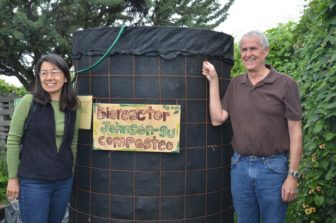Bringing the Soil Back to Life
Healthy soil is teaming with life in the form of billions of microscopic soil organisms. A teaspoon of healthy soil can contain more soil microorganisms than there are people on earth. The soil microorganisms found in healthy, or “living soil,” have important functions including converting nutrients for plants, building soil structure, improving how soil absorbs water, and allowing soil to draw down and sequester more carbon.
Unfortunately not all soil is alive and healthy. According to the United Nations (UN), a third of the earth’s soils are severely degraded. Soils that have been degraded by degenerative forms of agriculture may have lost the living organisms that allow soil to perform the functions necessary for the health of plants and the environment.
Dr. David C. Johnson, molecular biologist and research scientist at the University of New Mexico, has developed a system that brings lifeless soils back to life by reintroducing beneficial microorganisms to the soil with biologically enhanced compost.
The Johnson-Su composting method creates compost teeming with microorganisms that improve soil health and plant growth and increase the soil's potential to sequester carbon. This simple composting method produces a biologically enhanced compost by creating an environment where beneficial soil microorganisms and thrive and multiply. When this biologically alive compost is applied to the soil the microorganisms inoculate the soil and work in harmony with growing plants to improve soil health and increase the amount of carbon drawn out of the atmosphere and into the soil.
Benefits of Johnson-Su Bioreactor Compost:
- Increases soil carbon sequestration
- Increases crop yield
- Increases soil nutrient availability
- Increases soil water-retention capacity
- Produces biologically diverse compost
- Produces nutrient–rich compost
- Results in a low-salinity compost
- Improves seed germination and growth rates
Benefits of Johnson-Su Bioreactor Composting System:
- Reduces water usage up to six times
- Reduces composting labor time by 66 percent
- Requires no turning and little manpower
- Is a low–tech process that can easily be replicated
- Can be made using a diversity of compost materials
- Produces no odors or associated insects
- Materials generally cost less than $35 USD and can be used for up to 10 times
- No leaching or groundwater contamination
See the following resources on how to build the Johnson-Su Bioreactor and the benefits of using the compost from this system.
Instructional Video on How to Build the Composting Bioreactor
Read and download the written manual on building the bioreactor here.
How is This Compost Different?
Compost is generally thought of as a way to apply nutrients to the soil. However, the Johnson-Su compost method's primary goal is to apply beneficial microbiology to increase overall soil health and function.
 Typical commercial windrow composting processes are often designed and operated for speed and maximum product flow. This focus does not allow the compost to degrade sufficiently. Instead, it produces an immature compost that in some cases is detrimental to plant growth. Most home composting methodologies require building of a pile and turning it at regular intervals. Both of these composting processes (windrow and pile) can produce undesirable smells, attract flies and pests, and be problematic with neighbors. The Johnson-Su method, requires little manual labor, no turning and produces no odors.
Typical commercial windrow composting processes are often designed and operated for speed and maximum product flow. This focus does not allow the compost to degrade sufficiently. Instead, it produces an immature compost that in some cases is detrimental to plant growth. Most home composting methodologies require building of a pile and turning it at regular intervals. Both of these composting processes (windrow and pile) can produce undesirable smells, attract flies and pests, and be problematic with neighbors. The Johnson-Su method, requires little manual labor, no turning and produces no odors.
The compost end product has the consistency of clay when mature. It can be applied as an extract, mixed as a slurry to coat seeds that you intend to plant in large farming operations, or be applied directly as a soil amendment. This compost can be used to restore biological functionality to soils from small to large farming operations and from third-world to advanced agroecosystems.
David Johnson Speaks About the Importance of Biologically Active Soils
In his presentation, molecular biologist at New Mexico State University Dr. David Johnson explains how "getting the biology right” is critical to creating significant increases in soil carbon stocks.
